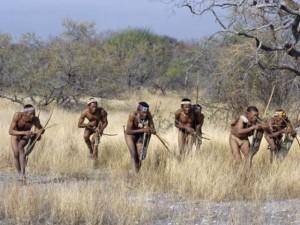While reading a recent book announcement from the MIT Press, I was reminded of Robin Ridington’s compelling argument that animism, or animist knowledge, can profitably be seen as a mode of production. The new book examines African hunter-gatherer technology from indigenous perspectives rather than the usual comparative mode, which is to view such technology through western lenses as “simple” or “primitive.” Here is a partial description from the MIT Press release:
In the border region where Zimbabwe, Mozambique, and South Africa meet, indigenous hunters have for centuries made and used an impressive array of tools. There is the bow, made from giant raisin trees and called the “vurha” or “uta” in the languages of two ethnic groups in the area, the chiShona and the xiTshangana. Local craftsmen make arrows (“matlhari” or “miseve”), knives (“mukwanga” or “banga”), and axes (“xihloka” or “demo”). Until the advent of colonial rule, villagers also dug pits lined with poison-tipped stakes (“goji” or “hunza”), where animals as big as elephants were captured.
“The hunt was a transient or mobile workspace where work was done on the move,” says Clapperton Chakanetsa Mavhunga, an associate professor in MIT’s Program in Science, Technology, and Society. “Boys were schooled in the arts of tracking, shooting, trapping, making weaponry, and using trees as assets for making poisons, medicines, food, and other purposes. The hunt was a professoriate of indigenous knowledge.”
These hunts were also incorporated within a highly spiritualized understanding of forests, animal life, and human behavior, Mavhunga emphasizes. For instance, hunters would never orphan an antelope fawn, and strict local taboos limited elephant hunting to basic needs for meat, skin, and ivory. Chiefs and spirit mediums enforced these rules.
Indeed, the maTshangana calendar is based, in part, on the life cycles of animals: “Mpala,” or November, is when antelopes give birth; “Nkokoni,” or December, is when wildebeest are born and elephants mate. No hunting was allowed during these months.
“Centuries of acquired and received knowledge were available on the annual rates of increase, out of which sustainable yields were calculated,” Mavhunga writes in a new book about technology, society, and nature in southern Africa.
In exploring the hunt as a mobile space for work and education, Mavhunga’s book — Transient Workspaces: Technologies of Everyday Innovation in Zimbabwe, just published by MIT Press — is a call for a historical rethinking about the meaning, prevalence, and application of technological innovation in Africa.
This remark strikes me as particularly apt: “The hunt was a professoriate of indigenous knowledge.” Indeed it was, and not just in Africa. Hunting knowledge, success, and skill required a lifetime of continuous education. The resulting expertise was surely professorial. I have not read Mavhunga’s book so can’t endorse yet endorse it, but readers interested in foragers might want to give it a try. If anyone does, please give us a review.


